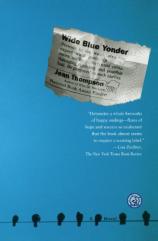Reading Group Guide
Discussion Questions
Wide Blue Yonder: A Novel

1. "There was always Weather. And every minute there was a new miracle," we learn in the opening passage of Wide Blue Yonder. What does the novel have to say about changeability of natural elements and the human condition?
2. Harvey has an unusual relationship with the Weather Channel. What sustenance does Harvey find in its programming? What purpose does it serve in his life? How do others perceive Harvey's interaction with the Weather Channel? Do these perceptions change at all? If so, how?
3. We witness characters in Wide Blue Yonder struggling with avoidance -- of reality, responsibility, even mortality. What are they afraid of and how, if at all, do they come to terms with these fears over the course of the novel?
4. Spoken word and silence each figure prominently in Wide Blue Yonder. Which characters rely most heavily on verbal expression? Is this tactic successful for these individuals? Discuss the role that silence plays throughout the book. Who is silent, and what consequences follow from this state of being? How do the silent people communicate with others?
5. The novel explores the connection between communication and love, both filial and romantic. As we meet the various characters and watch their relationships evolve, how does communication function in each instance?
6. Examine how Thompson has structured the novel. How does its structure relate to its various themes? Consider the narrative point of view.
7. "You know, Frank, I don't think of Harvey as crazy. More like he's on this different plane where there aren't any good or bad people, just good or bad weather," Elaine comments. What light do the characters Harvey, Mitch, and Rolando shed on the question of morality? What other moral issues does Wide Blue Yonder address? In the world Thompson has created, what determines if someone is good or bad? Is it possible for an individual to change?
8. Discuss the significance of Josie's relationship with the Abraham Lincoln statues in Springfield, Illinois. What cultural connotations does Lincoln carry for Americans? How do these ideas intersect with the themes of the novel?
9. Talk about the varying portraits of women (Josie, Elaine, Rosa, Teeny) in Wide Blue Yonder.
10. Family is an important corollary to the discussion of women. Describe the different families that we meet throughout the novel. Would you consider them emblematic of American society? How does each of the female characters influence the nature of her family and how the unit fares as part of a larger social structure?
11. Wide Blue Yonder contrasts the role of people as individuals and as members of society. On many levels power defines our society. What power hierarchies has Thompson set up within the novel? What forms does power take? Discuss the importance of race and class to the story. What significance, if any, does Elaine's factory in India have?
12. How is intelligence defined and perceived in Wide Blue Yonder? Discuss the different forms it takes and how each of these forms is valued.
13. Discuss how Wide Blue Yonder challenges us to reexamine our assumptions about several core paradigms: sanity and insanity, happiness and discontent, love and hate.
Wide Blue Yonder: A Novel
- Publication Date: December 31, 2002
- Paperback: 368 pages
- Publisher: Simon & Schuster
- ISBN-10: 0743229584
- ISBN-13: 9780743229586








